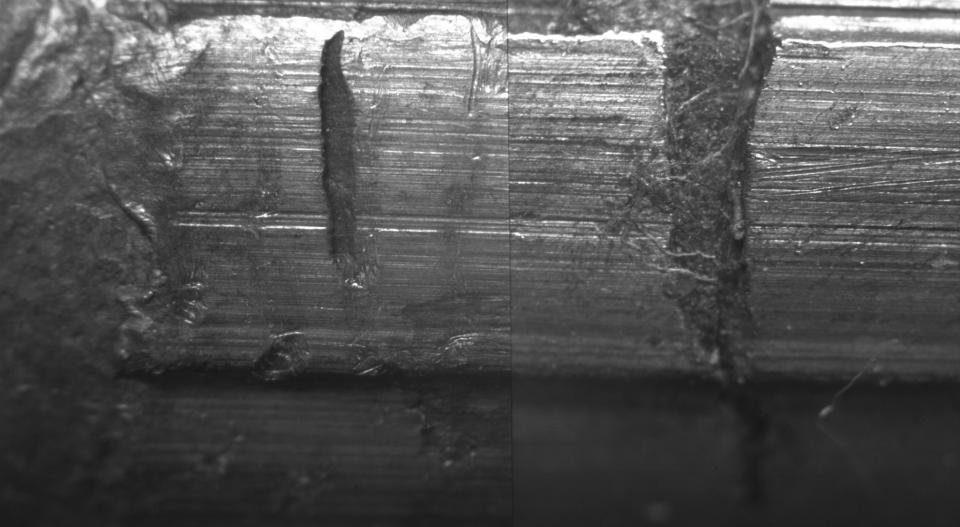 Firearms and Toolmarks evaluates firearms, fired bullets, fired cartridge cases, tools and toolmarks. Firearms are evaluated for functionality through examination and test firing. The test fired bullets and cartridge cases from the firearm are used for microscopic comparison. Imperfections on the firearm are transferred onto ammunition components upon firing. The imperfections allow analysts to determine if fired ammunition components were fired in the same firearm or different firearms.
Firearms and Toolmarks evaluates firearms, fired bullets, fired cartridge cases, tools and toolmarks. Firearms are evaluated for functionality through examination and test firing. The test fired bullets and cartridge cases from the firearm are used for microscopic comparison. Imperfections on the firearm are transferred onto ammunition components upon firing. The imperfections allow analysts to determine if fired ammunition components were fired in the same firearm or different firearms.
Tools and items with toolmarks can be submitted for examination and microscopic comparison. The tools are examined and tests for comparison are acquired by using the tool on test materials. The tests are compared with the toolmarks on evidence items.
Analysts conduct muzzle-to-target distance determination estimates. This can be done by the comparison of muzzle blast damage, gunpowder patterns, or shotgun pellet patterns.
Day in the Life - Firearms & Toolmarks
Services
Firearms
| Test firing for microscopic comparisons of a known to an unknown
Fired bullets, cartridge cases, and other fired components can be microscopically examined and compared to each other Barrel and overall length determination
Trigger pull measurements
Full-automatic testing
Hazardous mechanical alterations
Homemade improvised firearm testing
Distance determination
|
Toolmarks
| |
Serial Number Recovery
| |
Firearms and Ammunition for Destruction
| The Laboratory destroys firearms and ammunition for State Law Enforcement Agencies per State Statue,
Chapter 968.20(3). Firearms are mechanically destroyed by the crime laboratory.
|
Documents
| Firearms/Toolmarks Submission Guidelines
|
Evidence Submission FAQs
Yes. However, if you have a firearm you cannot unload or don’t know how to unload, please contact the firearms unit for assistance on how to submit the firearm before coming to the laboratory for safety reasons. We may be able to assist you in unloading the firearm or determining if it is loaded prior to submission.
Normally, no. The lab has an ample supply of available test ammunition for most examinations. However, unfired ammunition may be requested if the firearm is in an obscure caliber where test ammunition may be difficult to find, or if it is needed for distance determination (i.e. muzzle-to-target) where the same ammunition could be beneficial in distance determination test firings.
Package and store the firearm submerged in water for submission to the lab. Water from the recovery site or tap water is acceptable. Continued submersion can keep the corrosion minimal until the firearm can be examined. Please contact the laboratory prior to submission of a firearm in water.
The variation in how the toolmarks are created (angles, pressures, depths, accelerated tool wear, etc.) make toolmark to toolmark identification difficult. Submission of the tool allows the examiner to create tests to replicate the variations observed for comparison and can give you the source tool that caused the toolmarks through microscopic identification.
Test FAQs
No. Fuming the firearm for fingerprints will not harm the gun for examination and test firing. Most fingerprint processing will not harm the firearm. Acid yellow processing is one exception (corrosive to metal).
No, there is no approved method for this type of test. The time since the gun was last fired cannot be accurately determined by firing residue in the barrel or smelling the barrel for firing vapors.
No, there is no approved method for this type of test. Most potential markings left on the bullet from the mouth of the cartridge case are obscured from the rifling impressing on the bullet in addition to potential impact/penetration damage.
No, there is no approved method for this type of test. The similarity of clones and replicas to real firearms makes it difficult to determine the authenticity of a firearm observed on a picture or video. One example is an airsoft AR-15 rifle replica that was so authentic that you could take the airsoft rifle apart and install an AR-15 parts kit on it to build a functional rifle.
No, there is no approved method for this type of test. Photos can be helpful in determining how the tool may have been used, and for potentially determining class characteristics. However, photographs cannot be used for microscopic comparisons.
Definition FAQs
There are no identifying marks left on the evidence item or it is an item that was not in direct contact with the firearm or tool.
There are some characteristics on evidence items similar to each other, but there isn’t enough individual information left on the items for identification to a common source. Causes can be impact/penetration damage, insufficient marks present, shallow rifling type (polygonal), corrosion, and others.